Classification Endmember Selection with Multi-Temporal Hyperspectral Data
Abstract
1. Introduction
2. Materials and Methods
2.1. Study Area
2.2. Hyperspectral Data
2.3. Pre-Processing
Atmospheric Correction
2.4. Processing
2.4.1. Data Subset
2.4.2. NDVI
2.4.3. Endmember Libraries
2.4.4. SAM Classification
2.5. Consistency Evaluation
3. Results
4. Discussion
5. Conclusions
Supplementary Materials
Author Contributions
Funding
Acknowledgments
Conflicts of Interest
References
- Foody, G.M. Thematic map comparison: Evaluating the statistical significance of differences in classification accuracy. Photogramm. Eng. Remote Sens. 2004, 70, 627–633. [Google Scholar] [CrossRef]
- Olofsson, P.; Foody, G.M.; Herold, M.; Stehman, S.V.; Woodcock, C.E.; Wulder, M.A. Good practices for estimating area and assessing accuracy of land change. Remote Sens. Environ. 2014, 148, 42–57. [Google Scholar] [CrossRef]
- Asadzadeh, S.; de Souza Filho, C.R. A review on spectral processing methods for geological remote sensing. Int. J. Appl. Earth Obs. Geoinf. 2016, 47, 69–90. [Google Scholar] [CrossRef]
- Bioucas-Dias, J.M.; Plaza, A.; Camps-Valls, G.; Scheunders, P.; Nasrabadi, N.M.; Chanussot, J. Hyperspectral remote sensing data analysis and future challenges. IEEE Geosci. Remote Sens. Mag. 2013, 1, 6–36. [Google Scholar] [CrossRef]
- Schowengerdt, R.A. Remote Sensing. Models and Methods for Image Processing, 2nd ed.; Cambridge University Press: New York, NY, USA, 1997. [Google Scholar]
- Zortea, M.; Plaza, A. Spatial preprocessing for endmember extraction. IEEE Trans. Geosci. Remote Sens. 2009, 47, 2679–2693. [Google Scholar] [CrossRef]
- Chang, C.-I. Hyperspectral Data Processing: Algorithm Design and Analysis; KLUwer Acdemic publisher: New York, NY, USA, 2013. [Google Scholar]
- Veganzones, M.A.; Graña, M. Endmember Extraction Methods: A Short Review. In Proceedings of the Knowledge-Based Intelligent Information and Engineering Systems, Zagreb, Croatia, 3–5 September 2008; pp. 400–407. [Google Scholar]
- Holman, F.H.; Riche, A.B.; Michalski, A.; Castle, M.; Wooster, M.J.; Hawkesford, M.J. High throughput field phenotyping of wheat plant height and growth rate in field plot trials using UAV based remote sensing. Remote Sens. 2016, 8, 1031. [Google Scholar] [CrossRef]
- Veloso, A.; Mermoz, S.; Bouvet, A.; Le Toan, T.; Planells, M.; Dejoux, J.F.; Ceschia, E. Understanding the temporal behavior of crops using Sentinel-1 and Sentinel-2-like data for agricultural applications. Remote Sens. Environ. 2017, 199, 415–426. [Google Scholar] [CrossRef]
- Youssef, A.M.; Abu Abdullah, M.M.; Pradhan, B.; Gaber, A.F.D. Agriculture sprawl assessment using multi-temporal remote sensing images and its environmental impact; Al-Jouf, KSA. Sustainability 2019, 11, 4177. [Google Scholar] [CrossRef]
- Shen, H.; Huang, L.; Zhang, L.; Wu, P.; Zeng, C. Long-term and fine-scale satellite monitoring of the urban heat island effect by the fusion of multi-temporal and multi-sensor remote sensed data: A 26-year case study of the city of Wuhan in China. Remote Sens. Environ. 2016, 172, 109–125. [Google Scholar] [CrossRef]
- Pal, S.; Ziaul, S. Detection of land use and land cover change and land surface temperature in English Bazar urban centre. Egypt. J. Remote Sens. Space Sci. 2017, 20, 125–145. [Google Scholar] [CrossRef]
- Frick, A.; Tervooren, S. A framework for the long-term monitoring of urban green volume based on multi-temporal and multi-sensoral remote sensing data. J. Geovis. Spat. Anal. 2019, 3, 6. [Google Scholar] [CrossRef]
- Mielke, C.; Boesche, N.K.; Rogass, C.; Kaufmann, H.; Gauert, C.; de Wit, M. Spaceborne mine waste mineralogy monitoring in South Africa, applications for modern push-broom missions: Hyperion/OLI and EnMAP/Sentinel-2. Remote Sens. 2014, 6, 6790–6816. [Google Scholar] [CrossRef]
- Gorji, T.; Sertel, E.; Tanik, A. Monitoring soil salinity via remote sensing technology under data scarce conditions: A case study from Turkey. Ecol. Indic. 2017, 74, 384–391. [Google Scholar] [CrossRef]
- Wei, J.; Liu, X.; Ding, C.; Liu, M.; Jin, M.; Li, D. Developing a thermal characteristic index for lithology identification using thermal infrared remote sensing data. Adv. Space Res. 2017, 59, 74–87. [Google Scholar] [CrossRef]
- Jakob, S.; Zimmermann, R.; Gloaguen, R. The need for accurate geometric and radiometric corrections of drone-borne hyperspectral data for mineral exploration: Mephysto-a toolbox for pre-processing drone-borne hyperspectral data. Remote Sens. 2017, 9, 88. [Google Scholar] [CrossRef]
- Glanz, H.; Carvalho, L.; Sulla-Menashe, D.; Friedl, M.A. A parametric model for classifying land cover and evaluating training data based on multi-temporal remote sensing data. ISPRS J. Photogramm. Remote Sens. 2014, 97, 219–228. [Google Scholar] [CrossRef]
- Thouvenin, P.A.; Dobigeon, N.; Tourneret, J.Y. Hyperspectral unmixing with spectral variability using a perturbed linear mixing model. IEEE Trans. Signal Process. 2016, 64, 525–538. [Google Scholar] [CrossRef]
- Kruse, F.A.; Kierein-Young, K.S.; Boardman, J.W. Mineral mapping at Cuprite, Nevada with a 63-channel imaging spectrometer. Photogramm. Eng. Remote Sens. 1990, 56, 83–92. [Google Scholar]
- Wei, J.; Ming, Y.; Jia, Q.; Yang, D. Simple mineral mapping algorithm based on multitype spectral diagnostic absorption features: A case study at Cuprite, Nevada. J. Appl Remote Sens. 2017, 11, 026015. [Google Scholar] [CrossRef]
- Swayze, G.A.; Clark, R.N.; Goetz, A.F.H.; Livo, K.E.; Breit, G.N.; Kruse, F.A.; Sutley, S.J.; Snee, L.W.; Lowers, H.A.; Post, J.L.; et al. Mapping advanced argillic alteration at cuprite, Nevada, using imaging spectroscopy. Econ. Geol. 2014, 109, 1179–1221. [Google Scholar] [CrossRef]
- JPL JPL | AVIRIS Data Portal. Available online: https://aviris.jpl.nasa.gov/dataportal/ (accessed on 18 February 2020).
- Goetz, A.F.H.; Srivastava, V. Mineralogical Mapping in the Cuprite Mining District, Nevada; NTRS: Chicago, IL, USA, 1985. [Google Scholar]
- Abrams, M.; Hook, S.J. Simulated ASTER data for geologic studies. IEEE Trans. Geosci. Remote Sens. 1995, 33, 692–699. [Google Scholar] [CrossRef]
- Van der Meer, F.D.; van der Werff, H.M.A.; van Ruitenbeek, F.J.A.; Hecker, C.A.; Bakker, W.H.; Noomen, M.F.; van der Meijde, M.; Carranza, E.J.M.; de Smeth, J.B.; Woldai, T. Multi- and hyperspectral geologic remote sensing: A review. Int. J. Appl. Earth Obs. Geoinf. 2012, 14, 112–128. [Google Scholar] [CrossRef]
- Clark, R.N.; Swayze, G.A. Evolution in imaging spectroscopy analysis and sensor signal-to-noise: An examination of how far we have come. In Proceedings of the Summaries of the Sixth Annual JPL Airborne Earth Science Worksho, Orlando, FL, USA, 4–8 March 1996; JPL Publication: Pasadena, CA, USA, 1996; pp. 4–8. [Google Scholar]
- Gowey, K.; Lundeen, S. AVIRIS—Airborne Visible/Infrared Imaging Spectrometer—Data Processing. Available online: https://aviris.jpl.nasa.gov/aviris/data_facility.html (accessed on 27 January 2020).
- Cooley, T.; Anderson, G.P.; Felde, G.W.; Hoke, M.L.; Ratkowski, A.J.; Chetwynd, J.H.; Gardner, J.A.; Adler-Golden, S.M.; Matthew, M.W.; Berk, A.; et al. FLAASH, a MODTRAN4-based atmospheric correction algorithm, its applications and validation. Int. Geosci. Remote Sens. Symp. 2002, 3, 1414–1418. [Google Scholar]
- Ustin, S.L.; Lay, M.C.; Li, L. Remote sensing of wetland conditions in West Coast salt marshes. Remote Sens. Model. Ecosyst. Sustain. 2004, 5544, 159. [Google Scholar]
- Adler-Golden, S.M.; Acharya, P.K.; Berk, A.; Matthew, M.W.; Gorodetzky, D. Remote bathymetry of the littoral zone from AVIRIS, LASH, and QuickBird imagery. IEEE Trans. Geosci. Remote Sens. 2005, 43, 337–347. [Google Scholar] [CrossRef]
- Kayadibi, Ö.; Aydal, D. Quantitative and comparative examination of the spectral features characteristics of the surface reflectance information retrieved from the atmospherically corrected images of Hyperion. J. Appl. Remote Sens. 2013, 7, 073528. [Google Scholar] [CrossRef]
- Rouse, J.W.; Hass, R.H.; Schell, J.A.; Deering, D.W. Monitoring vegetation systems in the great plains with ERTS. In Proceedings of the Third Earth Resources Technology Satellite (ERTS) Symposium, Greenbelt, MD, USA, 10–14 December1973; Volume 1, pp. 309–317. [Google Scholar]
- Rogge, D.M.; Rivard, B.; Zhang, J.; Sanchez, A.; Harris, J.; Feng, J. Integration of spatial—Spectral information for the improved extraction of endmembers. Remote Sens. Environ. 2007, 110, 287–303. [Google Scholar] [CrossRef]
- Kokaly, R.F.; Clark, R.N.; Swayze, G.A.; Livo, K.E.; Hoefen, T.M.; Pearson, N.C.; Wise, R.A.; Benzel, W.M.; Lowers, H.A.; Driscoll, R.L.; et al. Base Spectra (splib07a). Available online: https://crustal.usgs.gov/speclab/QueryAll07a.php (accessed on 16 April 2019).
- Pearson, P.K. Mathematical Contributions to the Theory of Evolution.—on A Form of Spurious Correlation Which May Arise When Indices Are Used in the Measurement of Organs. Proc. Royal Soc. Lond. 1897, 60, 273–283. [Google Scholar]
- Microsoft Spreadsheet Software—Excel Free Trial—Microsoft Excel. Available online: https://products.office.com/en-us/excel (accessed on 31 March 2020).
- Kruse, F.A.; Lefkoff, A.B.; Boardman, J.W.; Heidebrecht, K.B.; Shapiro, A.T.; Barloon, P.J.; Goetz, A.F.H. The spectral image processing system (SIPS)-interactive visualization and analysis of imaging spectrometer data. Remote Sens. Environ. 1993, 44, 145–163. [Google Scholar] [CrossRef]
- Dennison, P.E.; Halligan, K.Q.; Roberts, D.A. A comparison of error metrics and constraints for multiple endmember spectral mixture analysis and spectral angle mapper. Remote Sens. Environ. 2004, 93, 359–367. [Google Scholar] [CrossRef]
- EL_Rahman, S.A. Performance of spectral angle mapper and parallelepiped classifiers in agriculture hyperspectral image. Int. J. Adv. Comput. Sci. Appl. 2016, 7, 55–63. [Google Scholar]
- Zhou, Q.; Jing, Z.; Jiang, S. Remote Sensing Image Fusion for Different Spectral and Spatial Resolutions with Bilinear Resampling Wavelet Transform. In Proceedings of the IEEE Conference on Intelligent Transportation Systems (ITSC), Shanghai, China, 12–15 October 2003; Volume 2, pp. 1206–1213. [Google Scholar]
- Bruzzone, L.; Prieto, D.F. Automatic analysis of the difference image for unsupervised change detection. IEEE Trans. Geosci. Remote Sens. 2000, 38, 1171–1182. [Google Scholar] [CrossRef]
- Shahriari, H.; Honarmand, M.; Ranjbar, H. Comparison of multi-temporal ASTER images for hydrothermal alteration mapping using a fractal-aided SAM method. Int. J. Remote Sens. 2015, 36, 1271–1289. [Google Scholar] [CrossRef]
- Jin, X. ENVI Automated Image Registration Solutions; Harris Geospatial Solution Inc.: Broomfild, Colorado, USA, 2018. [Google Scholar]
- Barazzetti, L.; Roncoroni, F.; Brumana, R.; Previtali, M. Georeferencing Accuracy Analysis of A Single Worldview-3 Image Collected over Milan. In Proceedings of the International Archives of the Photogrammetry, Remote Sensing and Spatial Information Sciences—ISPRS Archives, Prague, Czech Republic, 12–19 July 2016; pp. 429–434. [Google Scholar]
- Harris Geospatial Solution Inc. Masks. Available online: https://www.harrisgeospatial.com/docs/masks.html (accessed on 21 January 2020).
- Harris Geospatial Solution Inc. Change Detection Analysis. Available online: https://www.harrisgeospatial.com/docs/ChangeDetectionAnalysis.html (accessed on 21 January 2020).
- Weier, J.; Herring, D. Measuring Vegetation (NDVI & EVI). Available online: https://earthobservatory.nasa.gov/features/MeasuringVegetation (accessed on 8 January 2019).
- Hashim, H.; Abd Latif, Z.; Adnan, N.A. Urban Vegetation Classification With Ndvi Threshold Value Method With Very High Resolution (Vhr) Pleiades Imagery. In Proceedings of the ISPRS—International Archives of the Photogrammetry, Remote Sensing and Spatial Information Sciences, Kuala Lumpur, Malaysia, 1–3 October 2019; Volume XLII-4/W16, pp. 237–240. [Google Scholar]
- Harris Geospatial Solution Inc. Fast Line-of-sight Atmospheric Analysis of Spectral Hypercubes. Available online: https://www.harrisgeospatial.com/docs/FLAASH.html (accessed on 12 August 2018).
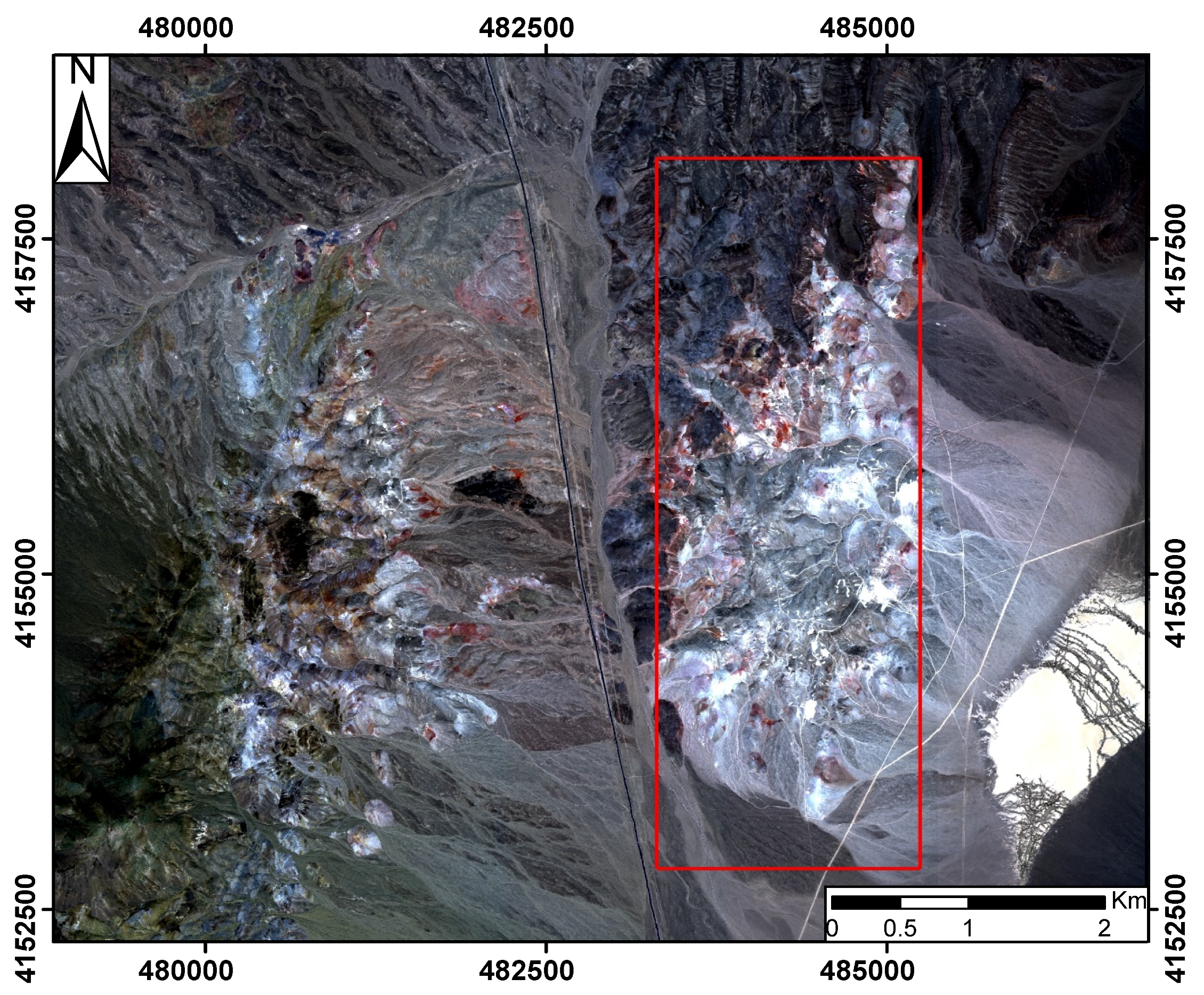
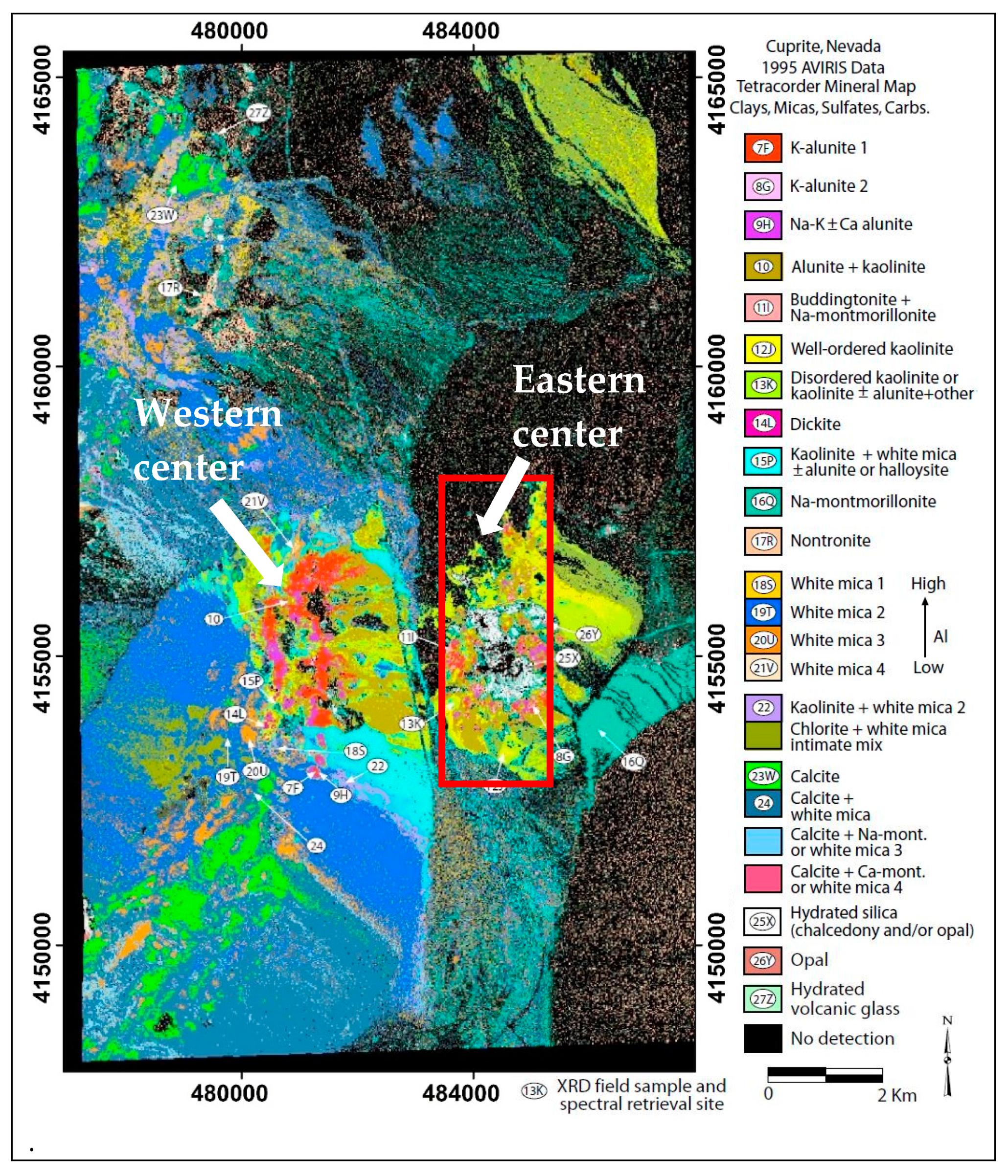


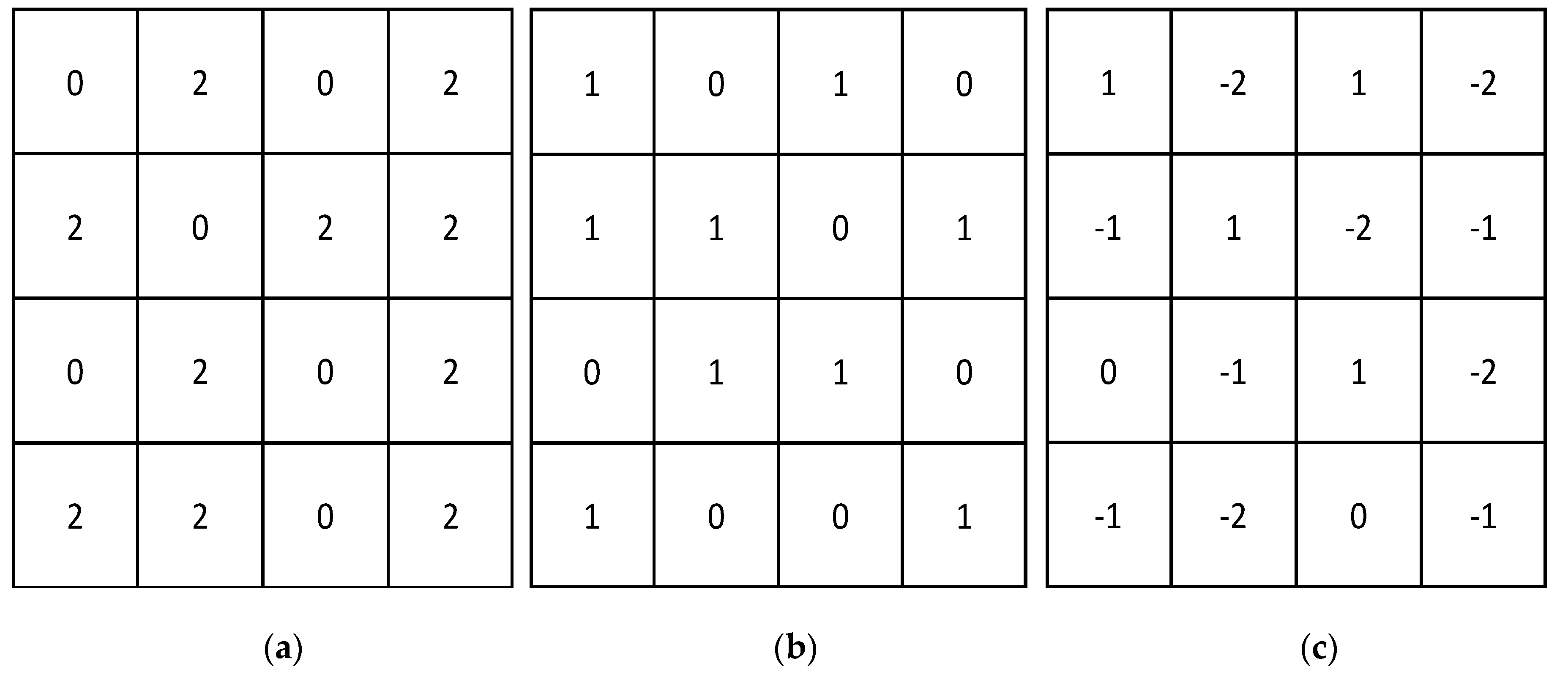
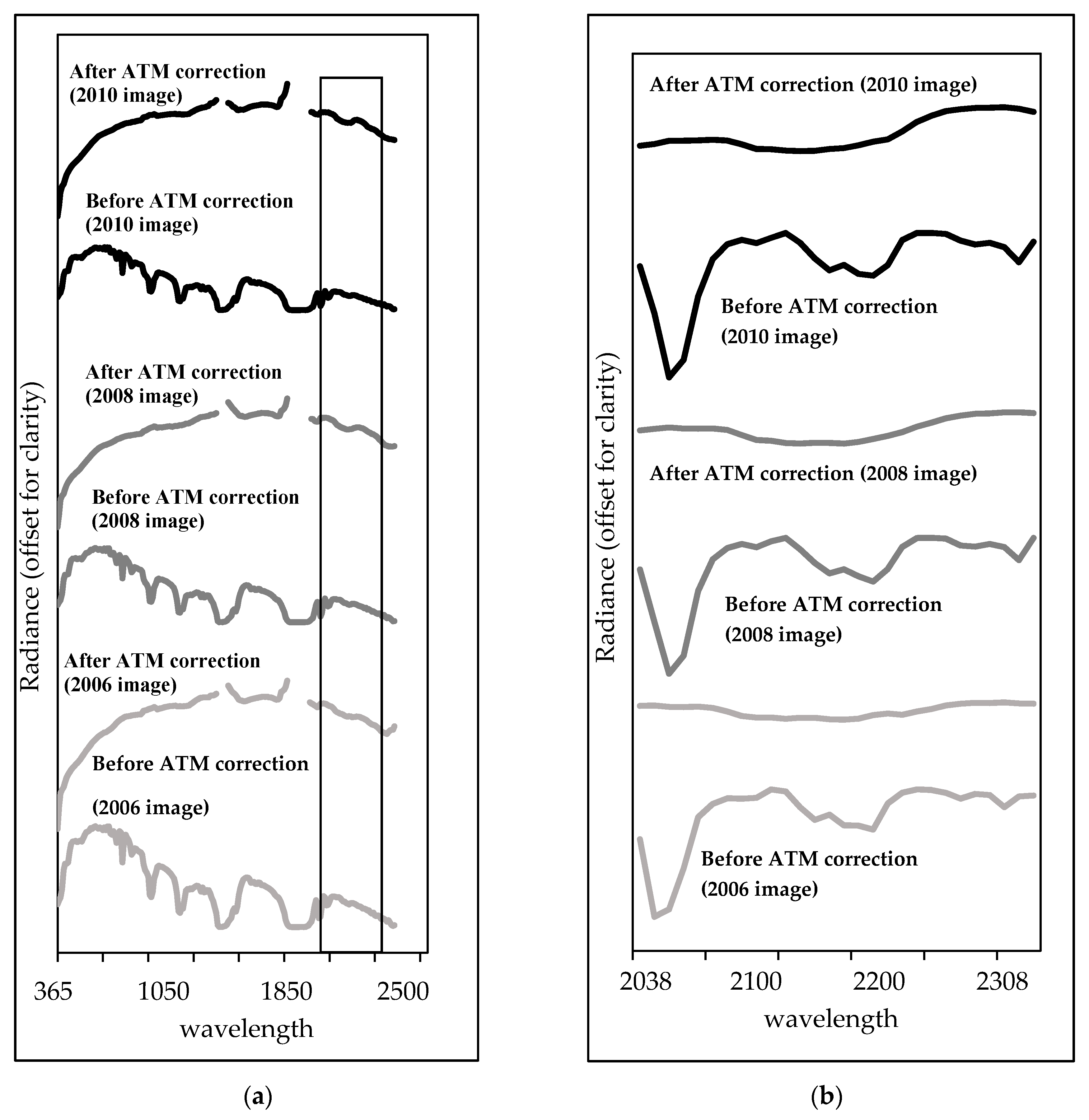
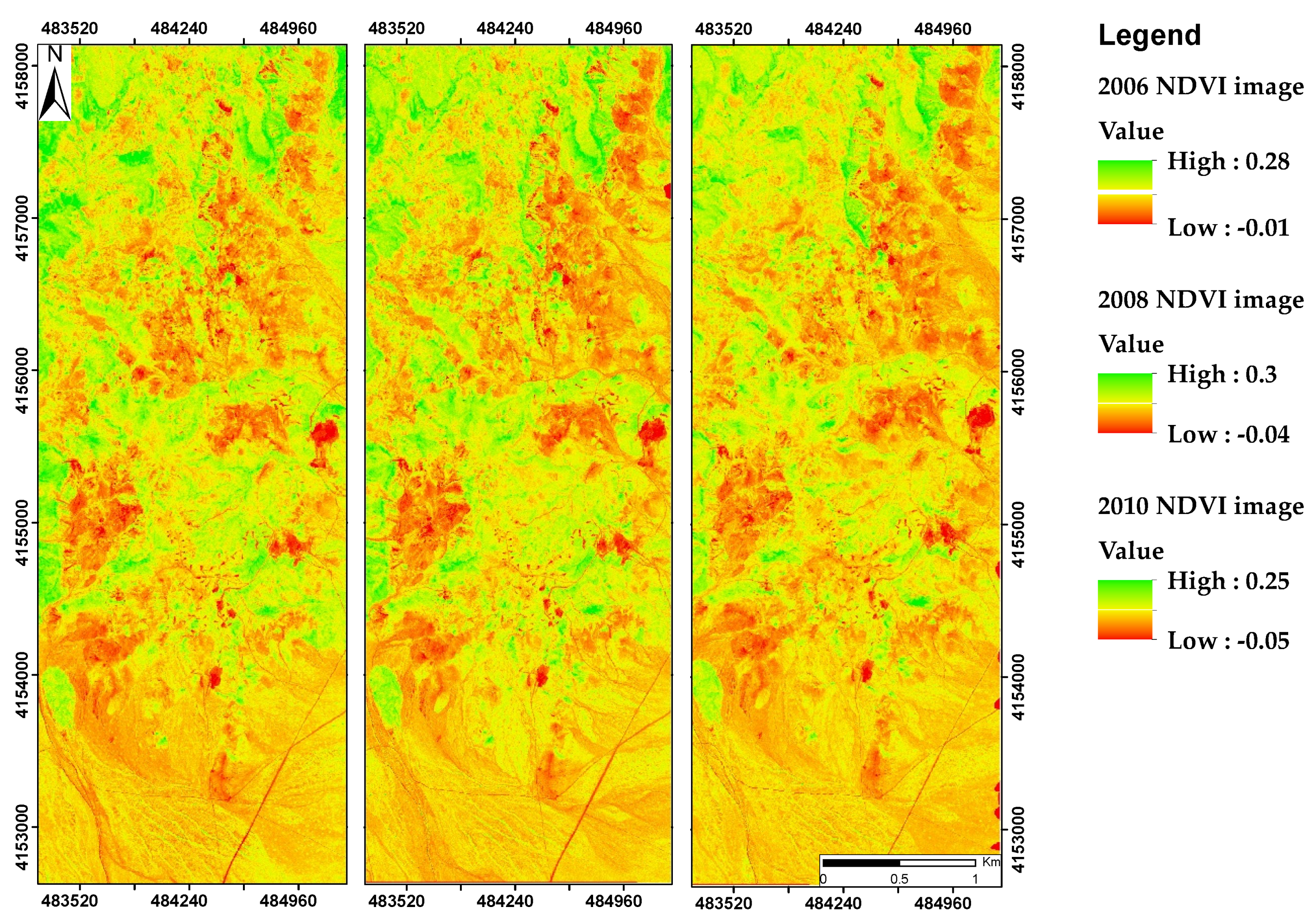
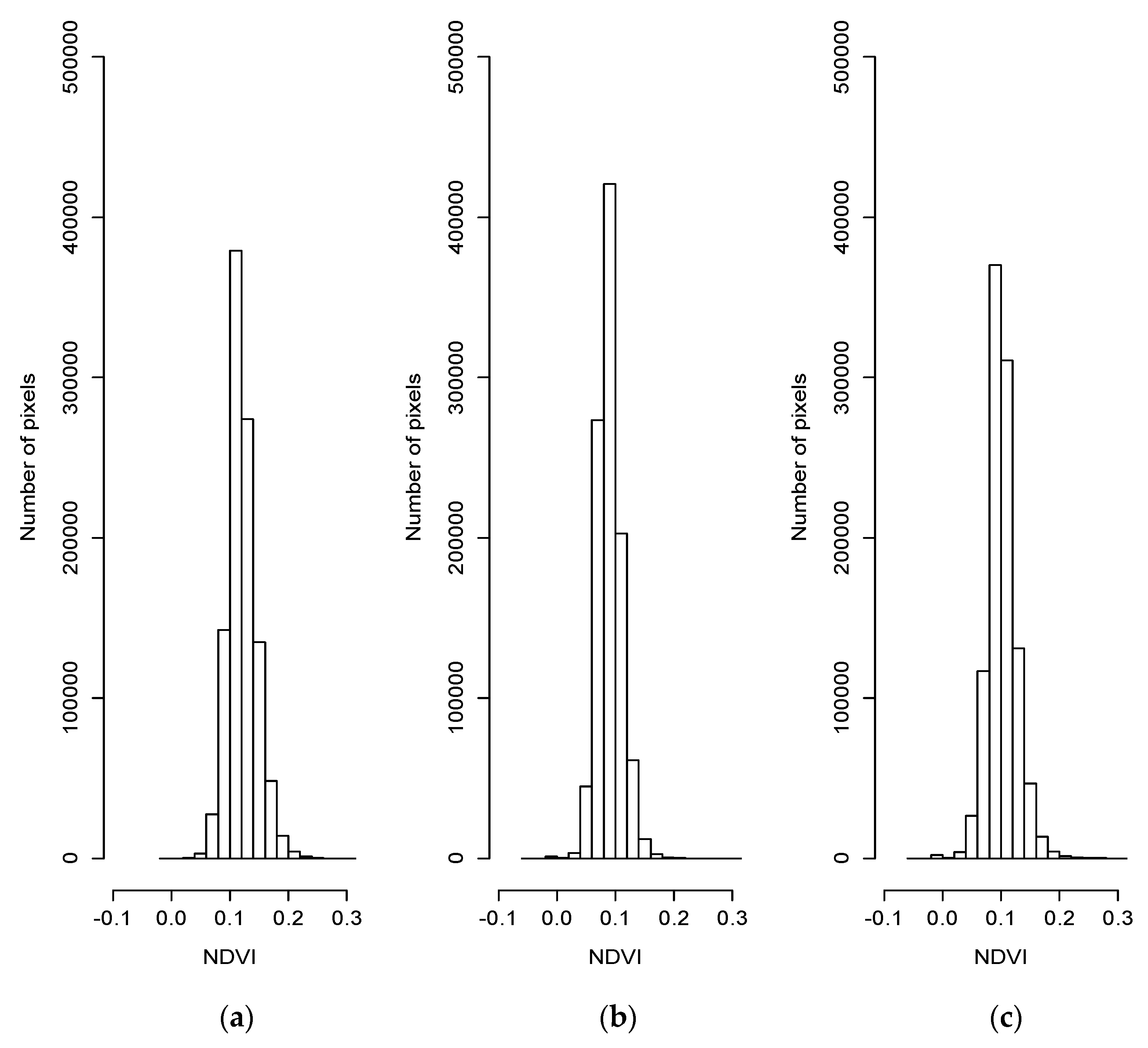

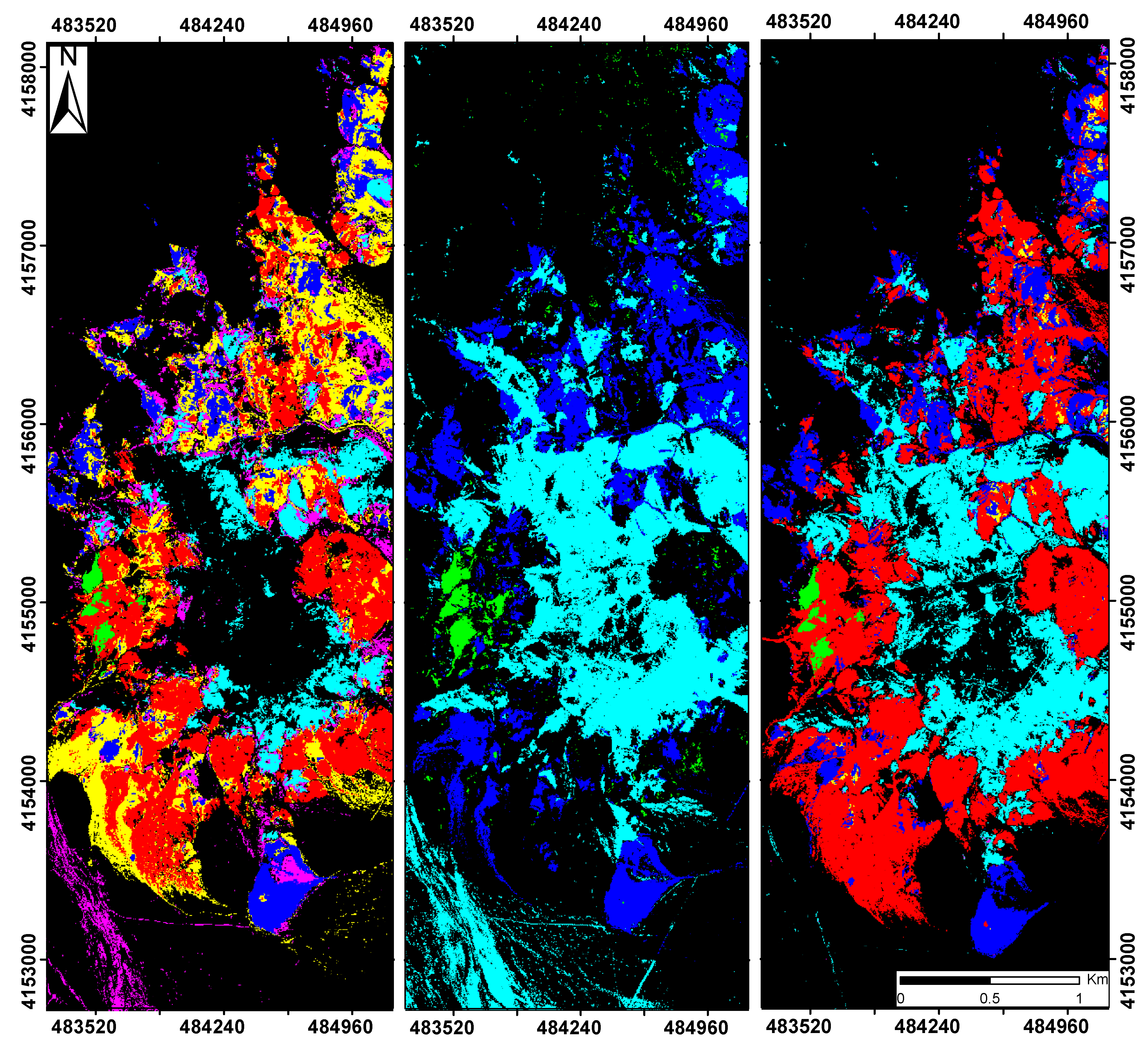
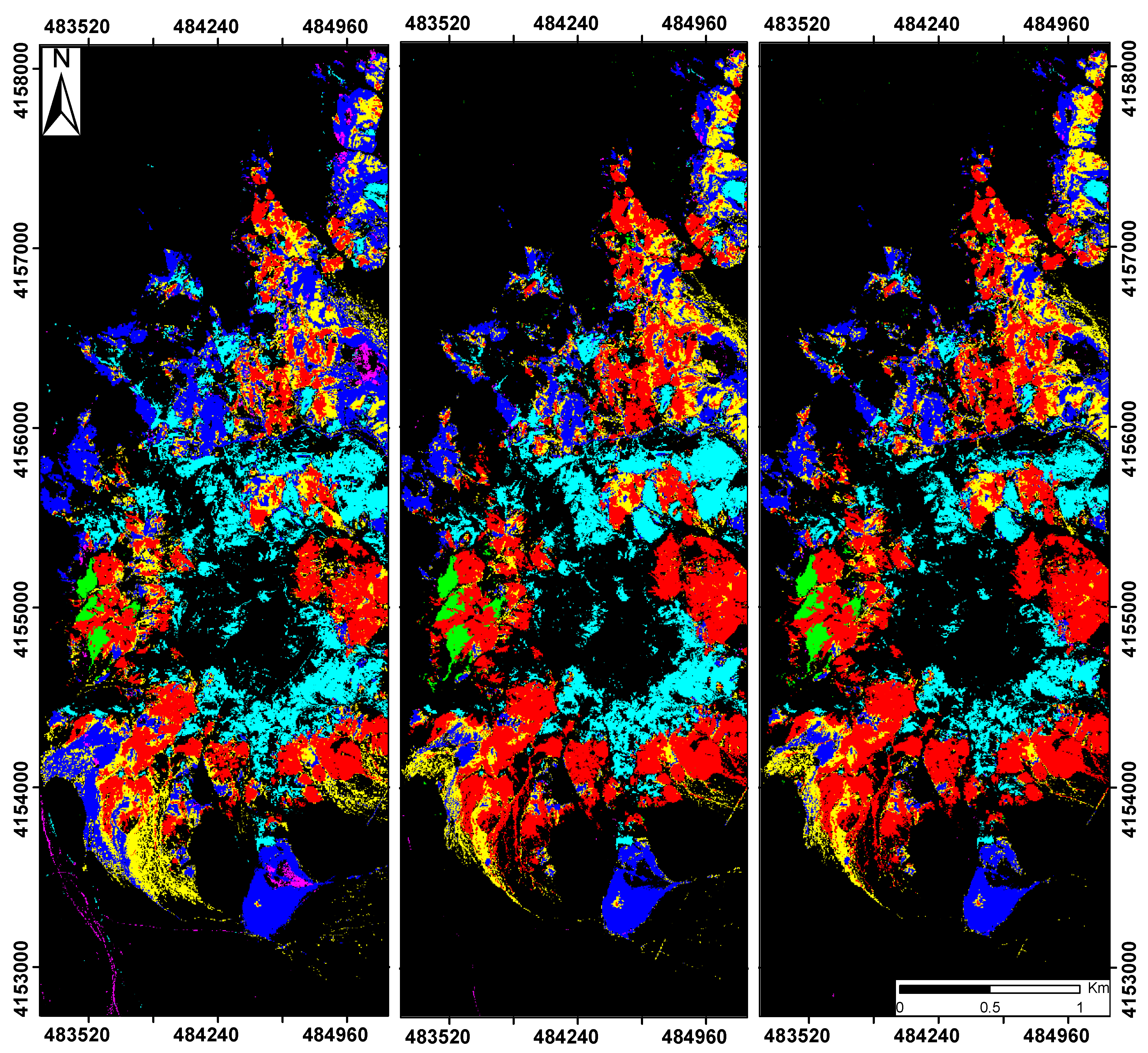

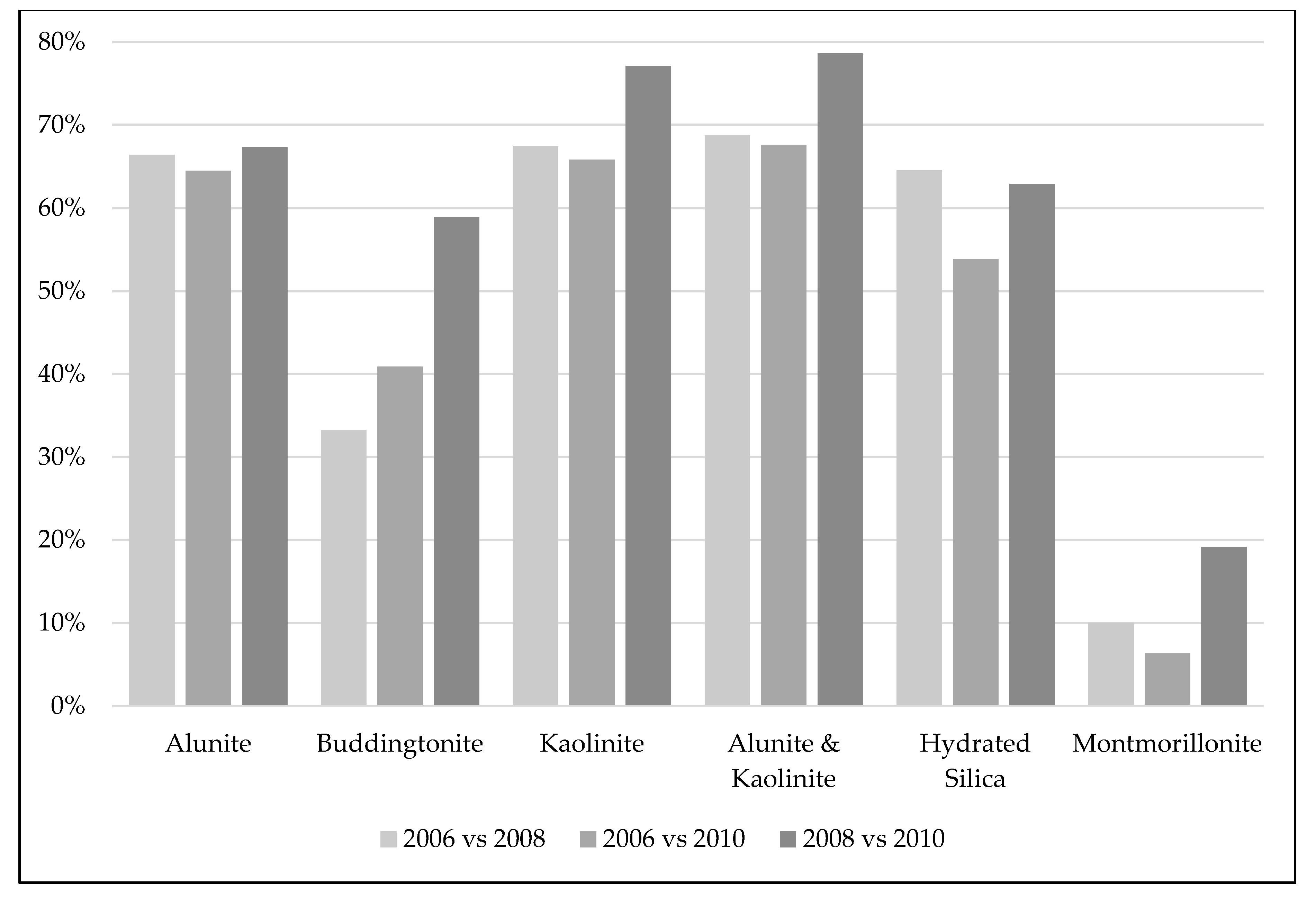
| Image | 2006 | 2008 | 2010 | ||
|---|---|---|---|---|---|
| Basic information | Product ID | f060502t01p00r05 | f080920t01p00r04 | f101014t01p00r04 | |
| Pixel Size (m) | 3.3 | 3.3 | 3.2 | ||
| Projection | UTM-11 | UTM-11 | UTM-11 | ||
| Datum | WGS-84 | WGS-84 | WGS-84 | ||
| Image acquisition information | Date | 2 May 2006 | 20 September 2008 | 14 October 2010 | |
| Time (UTC) | 19:02 | 18:39 | 20:22 | ||
| Sensor | AVIRIS | AVIRIS | AVIRIS | ||
| Center location | Lat | 37°30′59.94″ | 37°32′46.70″ | 37°32′20.91″ | |
| Lon | −117°10′38.88″ | −117°10′42.54″ | −117°10′44.73″ | ||
| Sensor altitude (m) | 5334 | 5334 | 5364 | ||
| Ground elevation (m) | 1400 | 1400 | 1400 | ||
| Atmospheric model | U.S standard | U.S standard | U.S standard | ||
| FLAASH atmospheric settings | Water retrieval | Yes | Yes | Yes | |
| Water absorption (nm) | 1135 | 1135 | 1135 | ||
| Aerosol retrieval | 2-Band (KT) | 2-Band (KT) | 2-Band (KT) | ||
| Aerosol model | Rural | Rural | Rural | ||
| Classified by | Mineral | Threshold | Mineral | Threshold |
|---|---|---|---|---|
| Minimum Value | Alunite | 0.08 | Kaolinite + Alunite | 0.11 |
| Buddingtonite | 0.09 | Hydrated silica | 0.035 | |
| Kaolinite | 0.11 | Montmorillonite | 0.02 |
| 2006 vs. 2008 | 2006 vs. 2010 | 2008 vs. 2010 | |
|---|---|---|---|
| Alunite | 0.995 | 1.000 | 0.995 |
| Buddingtonite | 0.993 | 0.997 | 0.995 |
| Kaolinite | 0.999 | 1.000 | 0.999 |
| Kaolinite + Alunite | 0.951 | 0.997 | 0.966 |
| Hydrated Silica | 0.990 | 0.997 | 0.996 |
| Montmorillonite | 0.975 | 0.985 | 0.994 |
| 2006 vs. Averaged | 2008 vs. Averaged | 2010 vs. Averaged | |
|---|---|---|---|
| Alunite | 0.999 | 0.998 | 0.999 |
| Buddingtonite | 0.998 | 0.998 | 0.999 |
| Kaolinite | 0.999 | 0.999 | 0.999 |
| Kaolinite + Alunite | 0.992 | 0.981 | 0.997 |
| Hydrated Silica | 0.997 | 0.998 | 0.999 |
| Montmorillonite | 0.989 | 0.996 | 0.998 |
© 2020 by the authors. Licensee MDPI, Basel, Switzerland. This article is an open access article distributed under the terms and conditions of the Creative Commons Attribution (CC BY) license (http://creativecommons.org/licenses/by/4.0/).
Share and Cite
Jiang, T.; van der Werff, H.; van der Meer, F. Classification Endmember Selection with Multi-Temporal Hyperspectral Data. Remote Sens. 2020, 12, 1575. https://doi.org/10.3390/rs12101575
Jiang T, van der Werff H, van der Meer F. Classification Endmember Selection with Multi-Temporal Hyperspectral Data. Remote Sensing. 2020; 12(10):1575. https://doi.org/10.3390/rs12101575
Chicago/Turabian StyleJiang, Tingxuan, Harald van der Werff, and Freek van der Meer. 2020. "Classification Endmember Selection with Multi-Temporal Hyperspectral Data" Remote Sensing 12, no. 10: 1575. https://doi.org/10.3390/rs12101575
APA StyleJiang, T., van der Werff, H., & van der Meer, F. (2020). Classification Endmember Selection with Multi-Temporal Hyperspectral Data. Remote Sensing, 12(10), 1575. https://doi.org/10.3390/rs12101575






